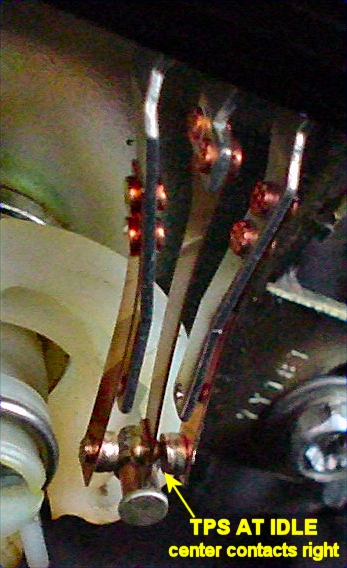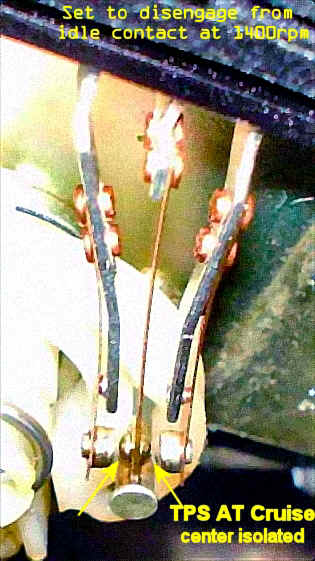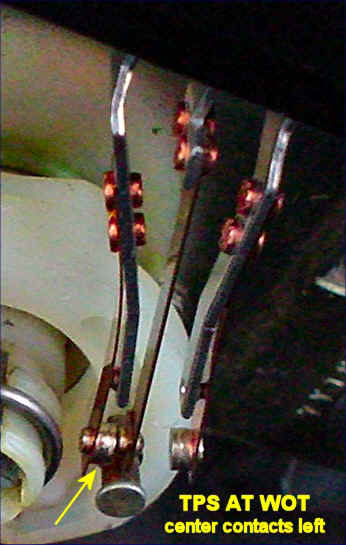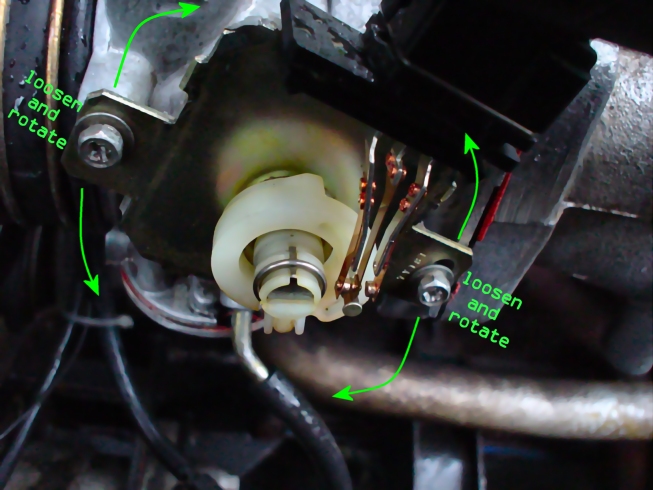IDLE

Throttle Position Switch at Idle
Throttle Position Switch (TPS)
('75-78 280z)
Overview
The TPS is simply a two position switch connected
to the so-called Engine Computer/Controller Unit aka ECU.
It is attached to the intake manifold and is moved by the throttle valve.
It's purpose is to tell the ECU
The ECU is programmed to give more fuel when the car is idling to improve smoothness. It is also programmed to give more fuel at WOT for more power.
In addition, the ECU also senses when the driver
removes foot from accelerator and activates a "coasting mode" aka
"Fuel Cut Mode". When the RPM is above 3200rpm and the TPS is in idle
position, the ECU cuts off fuel until the RPM's drop below 2800.
IDLE

Throttle Position Switch at Idle
At idle the center and right contacts are closed (touching). The ECU senses this and adds more fuel to the engine so it will idle smoother.
CRUISE

Throttle Position Switch at Cruise
(between 1400 rpm and full)
Just over 1400rpm, the center contact should break away from the right contact. The ECU senses this and stops the "rich" fuel to the engine. This means the engine is slightly leaner when cruising to give better fuel economy.
WOT (Go Dog Go)

Throttle Position Switch at(near) full
Throttle
When the gas pedal is pressed to the floor, the center contact contacts the left contact. This is sensed by the ECU and it sends more fuel (rich) to the engine. (Actually the switch closes a little before the pedal is to the flow... somewhere ~ 2/3's of the way is typical)
Setting the TPS on a '75 to '78 280z

Simply loosen the two philips screws and have a
friend hold the engine at 1400 rpm.
Rotate the whole TPS so that the center and right contacts are separated by a
"hair".
Side Effects of an improperly configured or faulty TPS
If your TPS is set wrong or contacts/connections are dirty, Your ECU may be sending too much or too little fuel at the wrong times or worse...go into fuel cut off "coast" mode at the wrong time. This will result in fuel flooding and fuel starving effects (surging, roughness, stalling, etc)
Also note that a bad tachometer signal to the ECU can also fool it into into Fuel Cut mode as well as stopping/starting idle enrichment at the wrong point.
Troubleshooting
Functioning:
Pop open plastic cover (with car off)
and watch contacts while rotating throttle valve by hand. Verify TPS contacts
open and close as expected.
Pop the electrical connector and use a continuity checker or multimeter to
verify switches are closing electrically (resistance between two pins goes to 0
ohms when the associated contacts close).
Start car and have friend hold engine RPMs at 1400 while watching idle and
center contacts. Verify these contacts disconnect at or above 1400rpm.
Dirty Contacts:
Pop open plastic cover (with car off) and
spray with a contact cleaner such as Caig DeOxit. You can also buy
contact/switch cleaner at Radio Shack and most electronic repair shops. Some
even use PB Blaster.
Stuck Contacts:
Pop open plastic cover (with car off)
and watch contacts while rotating throttle valve. If they are stuck due to
fusing or a contaminant, simply pull apart, renew contact surfaces with a small
file or sand paper then spray with a contact cleaner.